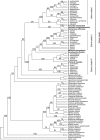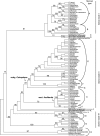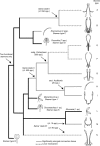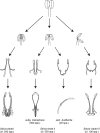Staminal evolution in the genus Salvia (Lamiaceae): molecular phylogenetic evidence for multiple origins of the staminal lever
- PMID: 16926227
- PMCID: PMC2735309
- DOI: 10.1093/aob/mcl176
Staminal evolution in the genus Salvia (Lamiaceae): molecular phylogenetic evidence for multiple origins of the staminal lever
Abstract
Background and aims: The genus Salvia has traditionally included any member of the tribe Mentheae (Lamiaceae) with only two stamens and with each stamen expressing an elongate connective. The recent demonstration of the non-monophyly of the genus presents interesting implications for staminal evolution in the tribe Mentheae. In the context of a molecular phylogeny, the staminal morphology of the various lineages of Salvia and related genera is characterized and an evolutionary interpretation of staminal variation within the tribe Mentheae is presented.
Methods: Two molecular analyses are presented in order to investigate phylogenetic relationships in the tribe Mentheae and the genus Salvia. The first presents a tribal survey of the Mentheae and the second concentrates on Salvia and related genera. Schematic sketches are presented for the staminal morphology of each major lineage of Salvia and related genera.
Key results: These analyses suggest an independent origin of the staminal elongate connective on at least three different occasions within the tribe Mentheae, each time with a distinct morphology. Each independent origin of the lever mechanism shows a similar progression of staminal change from slight elongation of the connective tissue separating two fertile thecae to abortion of the posterior thecae and fusion of adjacent posterior thecae. A monophyletic lineage within the Mentheae is characterized consisting of the genera Lepechinia, Melissa, Salvia, Dorystaechas, Meriandra, Zhumeria, Perovskia and Rosmarinus.
Conclusions: Based on these results the following are characterized: (1) the independent origin of the staminal lever mechanism on at least three different occasions in Salvia, (2) that Salvia is clearly polyphyletic, with five other genera intercalated within it, and (3) staminal evolution has proceeded in different ways in each of the three lineages of Salvia but has resulted in remarkably similar staminal morphologies.
Figures






References
-
- Ahlenslager K. Erythrostachys. USA: University of Montana; 1984. Systematic studies of Salvia subg. Calosphace sect. Masters thesis.
-
- Alziar G. Catalogue synonymique des Salvia L. du monde (Lamiaceae) Biocosme Mesogéen. 1988–1993;5(3–4):87–136. I.–VI. 6 (1–2, 4): 79–115, 163–204; 7 (1–2): 59–109; 9 (2–3): 413–497; 10 (3–4): 33–117.
-
- Baikova E. Two ways of stamen development in the subgenus Calosphace (Salvia, Lamiaceae) Botanicheskii-Zhurnal-(St.-Petersburg) 2002;87:71–78.
-
- Baikova E. Structural types and morphogenesis of stamens in the genus Salvia (Lamiaceae) Botanicheskii-Zhurnal-(St.-Petersburg) 2004;89:881–895.
-
- Barraclough TG, Vogler AP, Harvey PH. Revealing the factors that promote speciation. Philosophical Transactions of the Royal Society of London Series B-Biological Sciences. 1998;353:241–249.
Publication types
MeSH terms
LinkOut - more resources
Full Text Sources
Molecular Biology Databases

